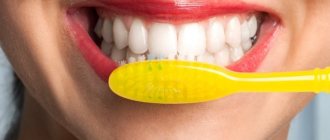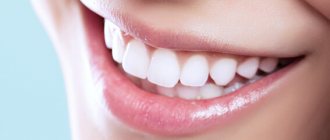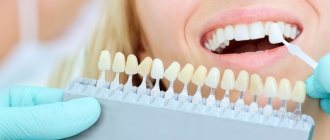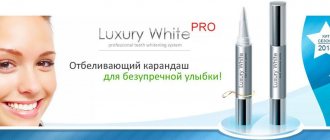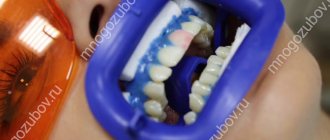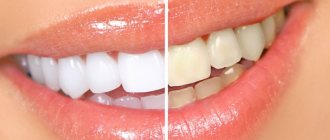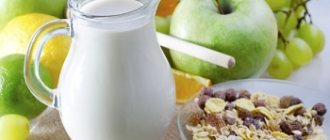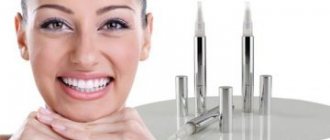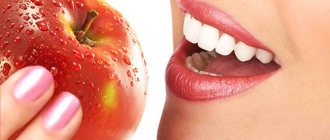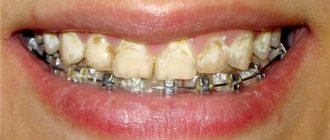In this article we will look at the best way to whiten your teeth without harming them. Today, having a Hollywood smile is a desire not only for representatives of show business, since the price of the procedure is affordable for many, and good teeth whitening products are not in short supply.
Unfortunately, now people do not pay attention to the advice and instructions of dental specialists; they cannot refuse a cup (possibly several) of coffee, chocolate, harmful carbonated sweet drinks, cigarettes, juices with dyes. And this is not the entire list of “enemies” of healthy snow-white teeth.
We will look at how whitening strips work in this article.
When dark spots and yellow plaque are discovered on once-white teeth, people panic, looking for information about methods of teeth whitening, reading reviews of those who were able to achieve a snow-white smile, studying methods to solve the problem and certainly running to the dental clinic.
We can say that in the modern world this branch of medicine is at a more than high level. Therefore, dentists offer a large number of different effective methods for solving this problem, the choice of which depends only on the wishes of the patients and the individual characteristics of the enamel.
All good teeth whitening products are diverse, differ in cost, purpose, and also in quality of the final result. Some specialists only support healthy teeth cleaning, while others can give anyone that Hollywood smile that stars of various sizes demonstrate on TV screens. Thus, it is necessary to be able to navigate the amount of information that exists to resolve this issue, and correctly choose the method that best suits and satisfies the wishes of each patient.
Many people think that this procedure is quite simple and harmless, but still, you should be very careful when choosing a method to whiten your teeth. It is clear that every person faced with this problem is interested in what the pros and cons of a particular procedure are. The answer is simple - there are positive and negative aspects with each method. As for price and effectiveness, they often depend on the individual structure of the teeth and the existing condition of the enamel. In this article we will also look at a home method of teeth whitening.
What teeth whitening methods are there?
In the practice of modern dental clinics, there is a certain list that includes several methods of whitening, divided into two groups, which include both professional (using special equipment with medical supplies, performed by a specialist) and at home. The latter means that the procedure is carried out at home, but not only with home remedies, but also with special preparations developed by dentists. This should be done under the supervision of a doctor. How to choose a good teeth whitening product?
Let's consider which products are the most popular and widespread of the professional options offered, as well as home and traditional methods of whitening that have proven themselves to be the best and are quite successful. In addition, we will identify all the pros and cons of these methods.
Just what the doctor ordered
If you are still determined to whiten your teeth at home, keep in mind that the most effective professional whitening products at home are products made in the USA:
- ExpertWhitening;
- Smile4You;
- Opalescence;
- Day White Excel AC.
The latest generation of products are most often made in the form of a gel. This consistency is more effective (the drug envelops the teeth and acts on the enamel for a long time) and safe (the risk of accidental burns from the acid composition is reduced).
The average duration of professional enamel lightening procedures is 1 hour. During this time, the product is applied several times, but after the first stage the effect is quite pronounced.
Folk remedies
Teeth whitening at home is not prohibited. To do this, you need to have an idea of safe means and not overdo it when carrying out the procedure. Since ancient times, a large number of folk remedies have been used that can freshen breath, eliminate dark plaque, give teeth shine and even achieve whitening by several shades. Such methods, undoubtedly, can cause a lot of doubts, discussions, discussions. And, of course, traditional methods of whitening have both their supporters and people who do not recognize them.
Recipes for teeth whitening with activated carbon:
- The paste is mixed with coal (it is better to choose a paste without a coarse abrasive). Then brush your teeth according to the standard pattern.
- Activated carbon is diluted to a paste, a few drops of lemon juice are added to it. The product should not be used if the teeth are sensitive.
- You can use a mixture of soda and coal. The powders are mixed with water and rubbed into the teeth with smooth movements. Cleansing is aggressive, so it cannot be used frequently.
- Coal is mixed with honey - this will make the product softer. Has a positive effect on gums.
Due to their availability and low cost, home remedies are very popular. Sometimes it is even higher than that of professional whitening methods. The most popular folk remedies include: hydrogen peroxide, baking soda, lemon (lemon juice or acid), wood ash, activated carbon, strawberries, etc.
The advantages of these methods include:
- affordable price for everyone;
- ease of use;
- If used correctly, you can achieve a whitening effect of more than one tone.
The disadvantages include:
- you never know what the end result will be in each case;
- the occurrence of side effects is possible.
Below we will present effective preparations for teeth whitening.
Products that whiten teeth at home
There are a number of “traditional medicine” remedies that you can use to whiten your teeth at home.
Activated carbon
Charcoal is a natural adsorbent that absorbs small particles and thereby cleanses the teeth. In addition, it has an anti-inflammatory effect and helps cleanse the entire oral cavity. There are several ways to lighten enamel:
- Crush two tablets finely, mix with 2-3 drops of water until a paste forms.
- Crushed charcoal is mixed with toothpaste.
- Instead of water, dilute the powder with tea tree oil.
Activated carbon can damage enamel.
These compounds are applied to the teeth for two minutes, after which they are washed off, then regular toothpaste is used. The use of activated carbon requires caution: even with thorough grinding, large particles remain that scratch the enamel.
Soda
Soda is considered an effective but unsafe remedy. It is used in the following combinations:
- with hydrogen peroxide (dilute to a paste);
- with lemon juice;
- with strawberry puree;
- with apple cider vinegar.
Traditional medicine advises brushing your teeth with one of these remedies for 3 minutes with a soft brush. The method cannot be used more than once a week.
Be extremely careful with baking soda.
Soda is an abrasive, aggressive substance. The short-term effect will be followed by problems - thinning of the enamel, leaching of microelements, increased sensitivity, and the formation of caries.
Hydrogen peroxide
Under the influence of hydrogen peroxide, the enamel brightens due to the fact that oxygen is released and destroys organic compounds that have accumulated on the enamel in the form of plaque. Peroxide is used as a dental treatment in the following ways:
- Rinse with two tablespoons for 1 minute.
- Cleaning with the addition of soda (until the consistency of mush). To make the product fragrant, add a drop of mint extract.
- A mask of a few drops of peroxide, a teaspoon of lemon juice, and the same amount of soda. The composition is applied to the enamel for two minutes.
Peroxide can weaken enamel.
Using peroxide as a bleach can be dangerous. This substance causes allergies, provokes caries, weakens enamel, and damages the mucous membrane.
Mouthguards
A wide range of inexpensive at-home whitening products include trays, whitening gels and strips, which can be purchased at almost any pharmacy. The main components at the heart of each of these products are hydrogen peroxide or carbamide peroxide. The difference between them lies only in the methods of application. You can purchase teeth whitening products at the pharmacy.
Since mouth guards are the most popular, let’s consider their use.
There are two options: some of them are developed based on the impression of a particular person’s teeth, the second are universal, which are manufactured in industrial conditions. It goes without saying that it is best to use custom-made mouthguards, due to the morphological characteristics of each oral cavity.
This is a unique teeth whitening system. There are reviews on this matter.
How to use this product? Everything is very simple: a mass that has a whitening property is placed in the trays, then they are put on the teeth and are not removed for a certain period of time, depending on the complexity of the plaque. The hydrogen peroxide and carbamide peroxide contained in the agent are capable of releasing oxygen, which, in contact with tooth enamel, performs the whitening function.
When choosing an active substance, you need to know that hydrogen will have a more visible effect, and urea is a softer and safer agent for enamel.
Which toothpaste is best for teeth whitening? More on this below.
It is best to discuss the time of wearing aligners with your dentist, as it depends on the condition of the teeth and enamel, and the whitening course can last up to 2 or even 3 weeks. In order for the obtained effect to be maintained, it is necessary to carry out the procedure 3-4 times every 6 months.
Pharmacy products for teeth whitening
A lot of products designed to restore the whiteness of a smile are sold in pharmacies. You can use them yourself, following the instructions.
Pastes
Pastes remove pigment deposits from the surface. This is due to the fact that they contain degrading enzymes and abrasive components. When choosing such teeth whitening products, you need to pay attention to the RDA abrasiveness coefficient. For regular pastes it is 75, for whitening pastes it is from 120. Examples of such pastes:
- LACALUT White with sodium fluoride, which reduces hypersensitivity;
- PRESIDENT White Plus – due to high abrasiveness (RDA 200) is used once a week;
- SPLAT whitening – contains pyrophosphates that dissolve tartar;
- ROCS - with two abrasive components and calcium, which promotes mineralization.
Be careful with the whitening paste and don't overdo it.
If the abrasiveness coefficient is above 120, the paste can only be used no more than once weekly. The product is not able to cope with hard deposits; professional cleaning by a dentist is necessary to remove them. Contraindication for use is increased enamel abrasion.
Gels
Gels contain carbamide peroxide. This substance interacts with saliva, releases oxygen, which penetrates into hard tissues and discolors dark pigments. It is better to whiten teeth with such means after professional cleaning: due to plaque, the whitening may be uneven. Peroxide does not affect crowns and fillings, so their color will not change. Examples:
- REMBRANDT plus , in addition to peroxide, contains a combination of Citroxain®, consisting of enzymes and polishing agents.
- ROCS – oxygen bleaching. It contains peroxide, but the abrasiveness is low, so surface deposits are difficult to remove.
The gel contains carbamide peroxide.
After a course of cleaning, it is recommended to use products with calcium to strengthen the enamel.
Rinse aids
Rinse aids are bleaching agents that perform several functions: they remove food debris, soft plaque, and freshen breath. Most popular brands:
- Colgate Plax is recommended as a complement to cleansing. A whole line of liquids is produced under this brand. The component of the whitening composition is zinc, which prevents the appearance of stains on the enamel. Thanks to other components, the liquid also has an antibacterial and remineralizing effect.
- PresiDENT White Plus . Contains Icelandic moss extract to prevent plaque formation. Thanks to its mint content, it provides fresh breath.
- SPLAT Whitening plus. The formation of plaque is prevented by the plant-derived papain enzyme and the Biosol component, and thyme oil prevents bleeding.
Rinse aids remove food debris, soft plaque, and freshen breath.
Pencils
The whitening effect of pencils is ensured thanks to special components:
- hydrogen peroxide, which removes plaque by reacting with oxygen;
- carbamide peroxide;
- bactericidal components, flavorings.
How can you clean your teeth with a pencil? The procedure is as follows:
- Rinse your mouth.
- Apply the gel from a pencil to your teeth.
- Maintain the amount of time indicated according to the instructions without closing your mouth.
- Rinse your mouth.
Popular pencil brands:
- Luxury White with peroxide and fluorine complex. The manufacturer promises 6 tones of lightening.
- Listerine Whitening Pen , which contains antibacterial agents. The expected result is 4 tones.
- BLIQ It is distinguished by its ability to form a film on the teeth, ensuring the safety of the enamel.
Whitening sticks contain hydrogen peroxide.
This method of lightening is suitable only as an auxiliary means. The use of a pencil is contraindicated in the presence of caries and enamel defects, since its action aggravates them.
Stripes
Whitening strips are clear strips designed to be applied to both rows. They are coated with a gel that acts upon contact with the enamel. It contains peroxides, which provide whitening by contact with oxygen and destruction of organic matter.
Manufacturers claim that with the help of strips you can whiten teeth up to 6 tones. They need to be used daily, for a course of 10-14 days (the duration is indicated in the instructions). The effect becomes noticeable after the third procedure. Disadvantages include increased sensitivity and uneven lightening as a result of the strip not tightly adhering to the surface.
Brands on the market:
- Crest is a line of products with different effects. The assortment includes strips for sensitive teeth, for maintaining whiteness, for various degrees of lightening - from 3 to 6 tones.
- White - strips intended for use 1 or 2 times a day, can change the shade by 3-4 tones.
- Rembrandt Intense does not need to be removed; they are designed to dissolve independently in the oral cavity after the effect ends.
- Two products are produced under this brand - for intensive express whitening and for gentle impact. In the first case, the effect is achieved in a week, in the second – in 14 days.
The strips should be used daily for 10-14 days.
Whitening strips
The strips contain hydrogen peroxide or carbamide peroxide. Below are the most popular ones:
- Crest. You can whiten your teeth in 10 days. Reviews about the product are neutral or positive.
- Bright Light. They are offered in two systems: classic and gentle for use at night while sleeping.
- Dr. White. A course for sensitive teeth is offered, which lasts two weeks.
Traditional methods of whitening
Carbonic
- Once a week for two months, carry out the procedure : mix one crushed charcoal tablet with your regular portion of toothpaste. Brush your teeth with the mixture. It is better to do it at night, as the tongue may become stained.
It does not give a long-term effect, but it does not cause harm either.
Soda
- Simply brush your teeth with baking soda. This method gives an excellent external effect, but very thins the tooth enamel. Very aggressive towards enamel.
With hydrogen peroxide
- After moistening a cotton pad in peroxide , wipe the enamel.
- Rinse your mouth.
- Brush your teeth with regular toothpaste. A very undesirable method, as it is aggressive towards teeth.
Strawberry
The most delicious way! Fresh strawberries are just meant to be eaten. Naturally, without sugar and sour cream!
Citric
Wipe your teeth every day with lemon peels. There are practically no contraindications.
Tea tree oil
It has an antiseptic whitening effect if you drop a couple of drops of oil onto your usual portion of toothpaste.
To achieve results, clean for two weeks.
Gel
Teeth whitening using gel is also popular. It can be used together with mouth guards, applied with a brush and with a toothbrush.
- Colgate Simple White.
- Global White.
- "Rox Pro"
- "Plus White."
- "Luxury White Pro".
- Listerine pencil.
- Pencil "Blik".
Cost of whitening products
Professional whitening (for two jaws):
- laser – from 15,000 rubles;
- Air Flow – from 7,000 rubles;
- Zoom 3 – from 25,000 rubles;
- LED – from 15,000 rubles.
Home remedies:
- whitening strips Crest Whitestrips 3D White – from 2,500 rubles;
- Crest toothpaste – from 500 rubles;
- Opalescence home whitening kit – from 18,000 rubles;
- kit for home teeth whitening White Kiss – from 1,800 rubles;
- Whitening mouth rinse Global White - from 240 rubles.
Professional whitening services do not always cost more. The newest home remedies are in approximately the same price range, so patients should weigh the possibility of getting white teeth in one hour versus spending several hours of their personal time on whitening without a guarantee of getting the desired effect.
AIR FLOW technique
Whitening using professional methods is performed in a clinic by a dentist. Special formulations are used here as bleaching agents, 1/3 of which consists of active substances. In addition, the effect is enhanced by catalysts (chemicals, heat, laser or ultraviolet light).
The Air Flow technique is not essentially whitening. It is more of a type of professional teeth cleaning that removes soft and hard surface plaque.
This method will be most effective in removing unstable dark spots that appear as a result of frequent consumption of large quantities of coffee or tea, as well as cigarette abuse. The active ingredients in this cleaning are baking soda and water mixed together. And the efficiency of water is enhanced by pressure.
Zoom technique
Zoom is a method based on photobleaching. The procedure has several stages:
- First, whitening gel is applied to the teeth.
- Then the properties of the gel are activated under the influence of a special lamp having beams of the required length.
This procedure lasts 2-3 hours, since the gel is applied more than once.
Positive and negative points
Pros of the procedure:
- the effect is noticeable - teeth are 12 shades whiter;
- the result appears immediately after the procedure;
- If you follow the doctor’s instructions correctly, the effect can last up to 5 years.
Disadvantages of this procedure:
- there is a strong increase in tooth sensitivity immediately after the procedure, which lasts about two days;
- gum irritation appears;
- the procedure is quite painful;
- the result can lead to unnatural whiteness of teeth;
- Not everyone can afford the price of the procedure.
In-canal and laser whitening
Intra-canal whitening is used in a situation in which one or more teeth are stained from the inside, as happens after filling the tooth canals with special materials that have the properties of changing the tone of dentin.
In this case, the whitening substance is applied inside the tooth cavity, and not on the surface, then the tooth is sealed for a while. Intra-canal bleaching is performed in two or three procedures, which must be carried out at intervals of several days. If this is not possible, crowns or veneers are installed.
When using a laser, the whitening gel is activated to the desired consistency. This procedure should be performed by specialists who know the nuances of teeth whitening without causing harm to the patient. Before carrying out the procedure, it is necessary to isolate the gums and mucous membranes so as not to expose them to the action of the active substance; this requirement is mandatory.
With this technique, you can use several types of lasers, which are represented by diode, erbium or gas options. Their choice is influenced by the intensity of the desired shade of the teeth. It is impossible to speak unambiguously about the result after this procedure, since it depends on individual characteristics. After this procedure, it is necessary to apply a gel that restores tooth enamel.

